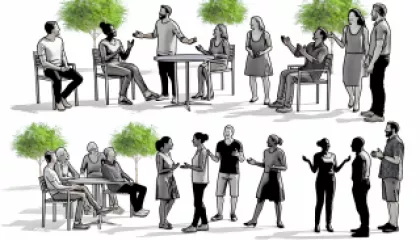Mastering Body Language: The Comprehensive Guide
In the world of communication, words aren't everything. In fact, non-verbal cues like body language often speak louder than our verbal expressions. Understanding and mastering body language can significantly enhance your personal and professional relationships. This comprehensive guide will walk you through the basics of body language, and provide you with practical insights and techniques to enhance your communication skills.
Understanding Body Language
Body language, also known as non-verbal communication, is an intricate part of human communication. It encompasses everything from our facial expressions, hand gestures, posture, eye contact, and even the way we breathe. Learning to read and interpret these cues can help us understand others better, and also enable us to communicate our own feelings and intentions more effectively.
Why is Body Language Important?
Our body language often communicates more about our feelings and intentions than our words do. In fact, renowned psychologist Albert Mehrabian's research suggests that 55% of communication is body language, 38% is tone of voice, and only 7% is the actual words spoken. This underlines the importance of understanding and using body language effectively.
The Basics of Body Language
Mastering body language begins with understanding its basic elements. These include facial expressions, eye contact, gestures, posture, and proximity.
Facial Expressions
Our faces are perhaps the most expressive part of our bodies. They can display a wide range of emotions without us uttering a single word. Happiness, sadness, anger, surprise, fear, and disgust are all emotions that can be easily read on our faces.
Eye Contact
Our eyes can express a multitude of emotions. They can show interest, attention, attraction, dominance, and even hostility. Maintaining appropriate eye contact can help establish a connection with the person we're conversing with.
Gestures
Gestures involve movements of our hands, arms, and even legs. They can indicate our level of engagement in a conversation, our thoughts, and feelings, and even our level of confidence.
Posture
The way we carry ourselves can indicate our level of self-confidence, openness, and attentiveness. For example, standing tall with your shoulders back indicates confidence, while slouching and looking down often suggests the opposite.
Proximity
The physical distance between people during a conversation often indicates their level of comfort and intimacy. For example, standing too close to someone might indicate familiarity or assertiveness, while standing too far might suggest discomfort or detachment.
Mastering Body Language: Practical Techniques
Now that we've understood the basics of body language, let's look at some practical techniques to master it. Remember, effective body language is about authenticity and consistency between your verbal and non-verbal communication.
Maintain Appropriate Eye Contact
Eye contact can establish trust and empathy. However, too much eye contact can make the other person uncomfortable. Try to maintain a balance. A good rule of thumb is to maintain eye contact for about 60-70% of the conversation.
Use Open Body Posture
An open body posture (uncrossed arms and legs, facing the person you're talking to) communicates openness and interest. On the contrary, a closed body posture (crossed arms or legs, turning away from the person) might communicate defensiveness or disinterest.
Control Your Facial Expressions
Our faces can reveal our true emotions. If you're feeling nervous but want to appear confident, try to control your facial expressions. Practice in front of a mirror until you can manage your expressions effectively.
Use Gestures Effectively
Gestures can emphasize the points you're making verbally. However, overusing or misusing gestures can be distracting and confusing. Use them sparingly and ensure they align with what you're saying.
Respect Personal Space
Ensure you respect the other person's personal space during a conversation. Invading someone's personal space might make them uncomfortable and could negatively affect the conversation.
Conclusion
In conclusion, body language is an integral part of human communication. By understanding its basics and applying practical techniques, we can enhance our communication skills, build better relationships, and succeed both personally and professionally. Remember, mastering body language takes time and practice, so be patient with yourself and keep practicing!






